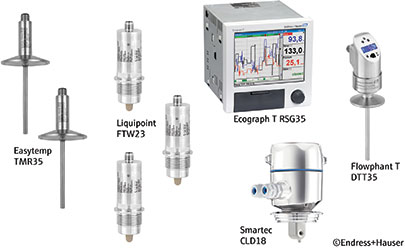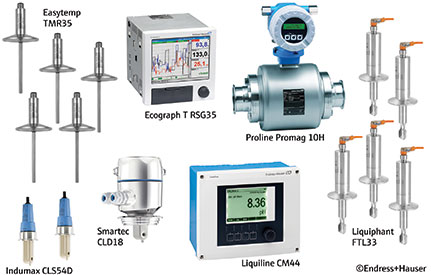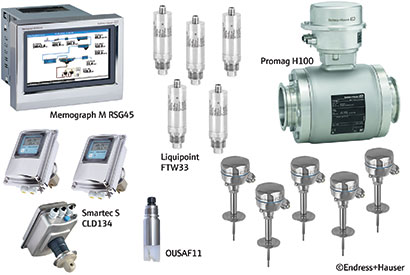
CIP (clean in place) system requirements vary, based on the size of the plant and amount of the investment. In a basic system: a flow switch, temperature sensor and conductivity sensor supplies the information necessary to execute the cleaning process. It is independent of the number of tanks used and ensures the desired temperature, velocity rate and concentration reached throughout the system.
CIP (clean in place) system requirements vary, based on the size of the plant and amount of the investment. In a basic system: a flow switch, temperature sensor and conductivity sensor supplies the information necessary to execute the cleaning process. It is independent of the number of tanks used and ensures the desired temperature, velocity rate and concentration reached throughout the system.
Limit switches in tanks or in front of the CIP supply pump ensure the system is always filled. A simple recorder combines the reporting of quality, relevant data with visualisation. The Flowphant works based on the thermal principle and shows there is flow in the system. The TMR135 temperature sensors – one after the heat exchanger and one in the backflow pipe – feed the system with media of a certain temperature and ensure that this temperature will be reached throughout the system. The CLD18 conductivity sensor displays the phase shift between media. The conductivity reading is used to calculate the concentration of cleaning agents. Liquipoint FTW23 capacitance limit switches help avoid pump damage by preventing dry-running. One switch in front of the supply pump, one in the caustic, and one in the acid tank each help to avoid system damage. The RSG35 data recorder displays and records the main information, temperatures, velocity and concentration. With a relay output, it can even stop the supply pump, according to a limit switch signal.
Starter package
The starter package (Figure 1) allows the CIP process to run automatically. Some sensors will be added into the tanks, while others will be added into the pipe to speed up the entire process and improve concentration and temperature levels. The temperature sensors remain the same because they are already equipped with Sensor on Tip technology. They are fast-reacting sensors that come with a welded hygienic process connection. In the standard package, they are installed in three tanks – water, caustic and acid – after the heat exchanger and in the backflow. The temperature control within the process gains speed because the tanks can be heated up internally before the CIP process is started. It is the same for the concentration of caustic and acid. Including a CLS54D conductivity sensor in each of the tanks will determine the concentration even when the CIP plant is not in operation, so the media are always properly prepared.

The conductivity sensor is equipped with an internal temperature sensor to compensate for the influence of changing temperatures. Connected to a central CM44x transmitter, the signals of both can be converted into the concentration. The transmitter (also available for DIN rail installation) can host up to eight sensors. This allows the phase shift meter in the backflow to be either a compact CLD18 or a CLS54D.
Basic system
In the intermediate system (Figure 2), the electromagnetic flowmeter Promag 10H replaces the flow switch. This hygienic sensor supplies the information more accurately than the Flowphant by using the flow rate signal. The Liquipoint limit switches are replaced by Liquiphant vibration point level switches. They are installed in the three tanks and positioned in front of the supply pump and the return pump. Liquiphant level switches are easier to commission and work with all liquid media, even if not conductive. They are the standard sensors in this application. The RSG35 still has the capacity to show and report all relevant data.

There are sensor options to choose from that improve the CIP control system. They supply information more accurately and faster, helping you to save water, energy, cleaning agents and time. The higher investment costs often return in a very short period due to reduced operational costs. In this regard, it is worth looking into the entire installation. Consequently, hygienic design adds some cost to a project, but the savings in every phase shift, during production or cleaning, support short return on investment periods.
Advanced system
In the advanced system (Figure 3), velocity is measured with a Promag H 100. It is based on the same hygienic sensor but equipped with a more sophisticated transmitter than the Promag 10H. After each cleaning, the HeartbeatT verification tool verifies the sensor worked within its specification. The Promag H 100 features empty pipe detection that recognises when the return pipe is completely filled, even when installed horizontally. Flow can still be measured when the pipe is not full, however an alarm signal is then given to suggest the system may not be cleaned completely. Two Smartec CLD134 compact devices are installed in the two agent tanks when a local display is needed. Two CLS54D sensors connected to the CM44P transmitter can be used to measure conductivity and directly calculate concentration when a local display is not needed.

The same contact device is used in the return line. It detects variation in the concentration of the returning cleaning liquid as fast as possible. The Smartec CLD134 is equipped with fast temperature compensation. Like the CLS54D, the CLD134 ensures stable results when dealing with changing media and temperatures.
The TM401 QuickSens is used to measure temperature and control the make-up in the tanks. The TM411 QuickNeck is installed in the backflow, after the heat exchanger. These temperature measurements are important to maintain consistent quality, and frequent sensor calibration provides the required level of safety. The QuickNeck is installed with a specific fixed bayonet thermowell so the entire loop can be calibrated without opening the process or cable connection. The spring-loaded Pt 100 element is still in close contact with the process and therefore has a fast t90 response time. The limit switches are replaced with a hygienic sensor that uses a combination of capacitance and conductivity technologies.
Supplying the same easy and flexible operation as the Liquiphant, the Liquipoint FTW33 can be installed flush mounted. This is the next step in hygienic design. The Liquipoint’s function can be easily tested with a service magnet, without opening the process. The central unit is changed to a RSG45 data recording and displaying system in order to properly display this complex system and record more values. The flexible, programmable touch-screen displays and operates the main functions of the plant.
The differentiator in this high-end system is the OUSAF11 absorption sensor. This sensor, connected to the same CM44P as the conductivity sensors, quickly detects when the majority of the product remains are flushed out of the system, enabling demand-driven (instead of time-controlled) flushing. This saves water and protects the caustic from being loaded more than needed. Nevertheless, the first caustic pumped through the system takes the majority of impurities with it. It makes sense to drain this caustic rather than to recycle it into the buffer tank, where it spoils the other caustic. This results in a better use of caustics and leads to lower costs.
The CIP system can be automated to any desired level – from basic installations with low capital expenditure, to hygienic high-end systems that ensure the shortest possible process down time through fast cleaning. The lowest possible consumption of water, energy and cleaning agents provide a return on the investment every day. The segmentation displayed above is only an example of how sensors can be matched to reach the expected results. Every plant and system will follow its own requirements and needs specific evaluation.
For more information contact Natlee Chetty, Endress+Hauser, +27 (0)11 262 8000, [email protected], www.za.endress.com
| Tel: | +27 11 262 8000 |
| Email: | [email protected] |
| www: | www.endress.com |
| Articles: | More information and articles about Endress+Hauser South Africa |

© Technews Publishing (Pty) Ltd | All Rights Reserved